Ireland
1880-1921
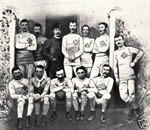 The Irish Football Association was set up in 1880 by clubs in the Belfast area and played their first international two years later, when they were beaten 13-0 by England. Based in Belfast, the IFA was responsible for the organisation of association football throughout the island of Ireland (then part of the United Kingdom) until a bitter dispute between Glenavon (based in Belfast) and Shelbourne (based in Dublin) over where a drawn Irish Cup replay should be held led to a split in the IFA and the formation of the Football Association of Ireland (FAI) in 1921.
The Irish Football Association was set up in 1880 by clubs in the Belfast area and played their first international two years later, when they were beaten 13-0 by England. Based in Belfast, the IFA was responsible for the organisation of association football throughout the island of Ireland (then part of the United Kingdom) until a bitter dispute between Glenavon (based in Belfast) and Shelbourne (based in Dublin) over where a drawn Irish Cup replay should be held led to a split in the IFA and the formation of the Football Association of Ireland (FAI) in 1921.
Sources:
 1882-1900
1882-1900
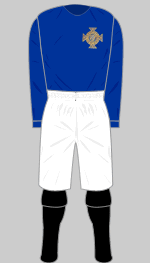
1882-1887
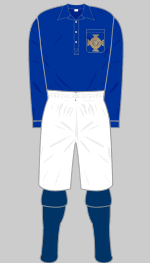
1887-1900
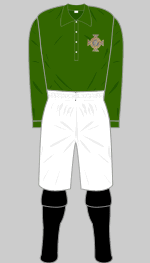
1886-1900 Change
Corroboration needed
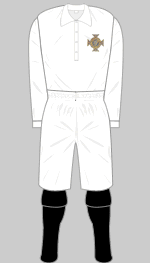
1886-1900 Change
Corroboration needed
Designer:
Ireland's original colours were "St Patrick's Blue" and white rather than the more familiar green and white we associate with Irish teams. In fact the association between Ireland and blue goes back to Norman times whereas green has been associated with Irish republicanism since the 1790s. Although the few team photographs to have survived appear to show the team in pale tops, The National Football Museum has an original shirt worn by Andrew Gara in 1902 that is a deep shade of blue, suggesting the contemporary photographs are misleading due to the peculiarities of the emulsion used.
Ireland's first game was against England at the Knock Ground in Belfast when they suffered a 0-13 defeat, a record that stands to the present day. In 1883 the Home International Tournament was inaugurated, which provided the four home nations with matches against each other every season. Ireland were the whipping boys of this competition for the rest of the century, finishing last on ten occasions and third on four.
The Irish team would have changed for games in Scotland and they are thought to have worn both white and green shirts in these matches. Both white and dark knickers are evident in some early team photographs suggesting that Ireland followed the practice of the English FA and required players to provide their own equipment apart from the shirts. By 1890 the entire team was kitted ut in white knickers but club socks were still worn.
 1900-1914
1900-1914
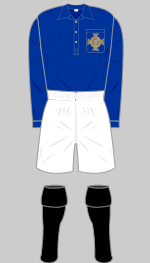
1900-1914
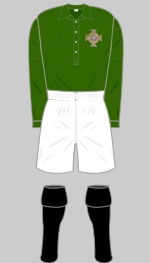
1900-1914 Change
Designer:
Blue remained the Irish team's first choice but the national amateur side wore green. A change kit was required every other year for the match with Scotland and I believe the first team borrowed a set of green tops from their amateur colleagues. A rare match programme from 1903 indicates that the Irish team wore green shirts in the match with England. Players provided their own club stockings. Generally Ireland remained the weakest of the four British teams but their performances did improve steadily. In 1903 they tied for the championship with England and Scotland and in 1914 they won it outright for the first time. It is established that the Irish wore blue shirts with collars throughout this period.
 1919-1921
1919-1921
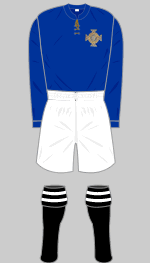
1919-1921
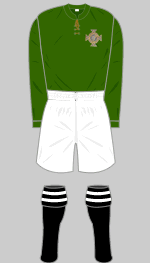
1920 Change
Designer:
International football resumed after the First World War in October 1919 when Ireland drew with England in Belfast, Ireland finishing last in both 1920 and 1921. Match worn shirts used by Patsy Gallagher, Hugh Davey and Alan Morton during the post war period confirm that the shade of blue worn remained deep blue. Change shirts would have been needed for thr mstch in Glasgow in March 1920.
In 1921, shortly before the partition of Ireland, the clubs playing in what would become the Irish Free State broke away from the Irish FA when that body ordered an Irish Cup replay between Glenavon and Shelbourne to be played in Belfast rather than Dublin. Ostensibly this was because of the security situation in the south but to the southern clubs and the Leinster FA, it was symptomatic of how the IFA neglected the development of the game in the south and discriminated against the clubs from outside Ulster.
See
Northern Ireland 1922-1939 :
Home Internationals Index :
Republic of Ireland 1922-1939
 The Irish Football Association was set up in 1880 by clubs in the Belfast area and played their first international two years later, when they were beaten 13-0 by England. Based in Belfast, the IFA was responsible for the organisation of association football throughout the island of Ireland (then part of the United Kingdom) until a bitter dispute between Glenavon (based in Belfast) and Shelbourne (based in Dublin) over where a drawn Irish Cup replay should be held led to a split in the IFA and the formation of the Football Association of Ireland (FAI) in 1921.
The Irish Football Association was set up in 1880 by clubs in the Belfast area and played their first international two years later, when they were beaten 13-0 by England. Based in Belfast, the IFA was responsible for the organisation of association football throughout the island of Ireland (then part of the United Kingdom) until a bitter dispute between Glenavon (based in Belfast) and Shelbourne (based in Dublin) over where a drawn Irish Cup replay should be held led to a split in the IFA and the formation of the Football Association of Ireland (FAI) in 1921. 1882-1900
1882-1900






